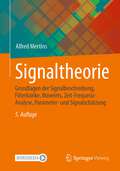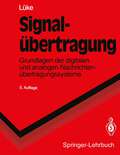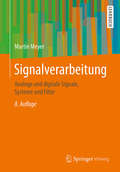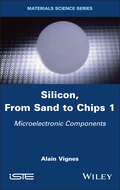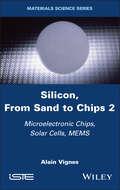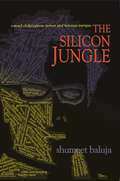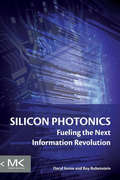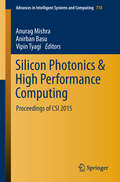- Table View
- List View
Signaltheorie: Grundlagen der Signalbeschreibung, Filterbänke, Wavelets, Zeit-Frequenz-Analyse, Parameter- und Signalschätzung
by Alfred MertinsDas Lehrbuch gibt einen systematischen Einstieg in die Signaltheorie und behandelt sowohl die in der Ingenieur-Literatur üblichen Werkzeuge zur Signal- und Systembeschreibung als auch die grundlegenden mathematischen Konzepte zur Interpretation von Signalen als Elemente von Vektorräumen und zur Signal-Approximation. Der Inhalt reicht von klassischen Transformationen über Wavelet-Transformationen und nichtlineare Zeit-Frequenz-Analyseverfahren bis hin zu optimalen Transformationen für zufällige Signale. Die Methoden werden dabei anhand zahlreicher Anwendungsbeispiele aus den Bereichen der Informationsverarbeitung, Signalkompression, Spektralanalyse, Störgeräuschreduktion und Parameterschätzung illustriert.
Signaltheorie: Grundlagen der Signalbeschreibung, Filterbänke, Wavelets, Zeit-Frequenz-Analyse, Parameter- und Signalschätzung
by Alfred MertinsDas Lehrbuch gibt einen systematischen Einstieg in die Signaltheorie und behandelt sowohl die üblichen Werkzeuge zur Signal- und Systembeschreibung als auch die mathematischen Konzepte zum Umgang mit Funktionen. Die Methoden werden dabei anhand zahlreicher Anwendungsbeispiele aus den Bereichen der Informationsverarbeitung, Signalkompression, Spektralanalyse, Störgeräuschreduktion und Parameterschätzung illustriert.
Signaltheorie: Grundlagen der Signalbeschreibung, Filterbänke, Wavelets, Zeit-Frequenz-Analyse, Parameter- und Signalschätzung
by Alfred MertinsZu den typischen Aufgabenstellungen der Signalverarbeitung gehören z. B. die Komprimierung von Sprach-, Audio- und Bildsignalen, die Signal- bzw. Prozessanalyse und die Datenübertragung. Die dabei angewandten Methoden sind äußerst vielfältig und das Verständnis der Algorithmen erfordert zum Teil weitgehende Kenntnisse der Signaltheorie. Ein wesentlicher Aspekt der Signaltheorie besteht darin, Methoden anzugeben, die besondere Einsichten in die Eigenschaften von Signalen bzw. von stochastischen Prozessen erlauben. Beispiele linearer Transformationen sind dabei die Karhunen-Love-, die Kurzzeit-Fourier- und die Wavelet-Transformation. Bei den nichtlinearen Analysemethoden ist die Wigner-Verteilung hervorzuheben. Hinzu kommen die modellgestützten Detektions- und Schätzverfahren. Dieses Lehrbuch ermöglicht dem Leser einen systematischen Einstieg in die Signaltheorie. Die Methoden werden dabei anhand zahlreicher Anwendungsbeispiele, die bis hin zu Fragestellungen jüngster Forschungsaktivitäten führen, illustriert. Vorausgesetzt werden Grundkenntnisse der Fourier-Transformation, der Beschreibung linearer Systeme und der Matrizenalgebra.
Signaltheorie: Grundlagen der Signalbeschreibung, Filterbänke, Wavelets, Zeit-Frequenz-Analyse, Parameter- und Signalschätzung
by Alfred MertinsDas Lehrbuch gibt einen systematischen Einstieg in die Signaltheorie und behandelt sowohl die in der Ingenieur-Literatur üblichen Werkzeuge zur Signal- und Systembeschreibung als auch die grundlegenden mathematischen Konzepte zur Interpretation von Signalen als Elemente von Vektorräumen und zur Signal-Approximation. Der Inhalt reicht von klassischen Transformationen über Wavelet-Transformationen und nichtlineare Zeit-Frequenz-Analyseverfahren bis hin zu optimalen Transformationen für zufällige Signale. Die Methoden werden dabei anhand zahlreicher Anwendungsbeispiele aus den Bereichen der Informationsverarbeitung, Signalkompression, Spektralanalyse, Störgeräuschreduktion und Parameterschätzung illustriert.
Signaltheorie und Kodierung (Springer-Lehrbuch)
by Peter VogelDieses Lehrbuch führt verständlich in ein abstraktes Fachgebiet ein. Das didaktische Konzept dafür beinhaltet die Entwicklung der theoretischen Grundlagen anhand von Beispielen, sowie Übungen mit Lösungen. Die Orientierung wird durch Strukturelemente wie Definitionen und Sätze erleichtert. Als mathematische Voraussetzung zum Verständnis werden lediglich Folgen und Reihen benötigt. Inhaltliche Schwerpunkte sind die Verarbeitung zeitdiskreter Signale durch lineare zeitinvariante Systeme, sowie die Kodierung dieser Signale. Gültigkeitsgrenzen werden aufgezeigt und hinter diese Grenzen geschaut.
Signalübertragung: Grundlagen der digitalen und analogen Nachrichtenübertragungssysteme (Springer-Lehrbuch)
by Jens Ohm Hans Dieter LükeDas seit 1975 eingeführte grundlegende Lehrbuch der Signalübertragung ist auch in der fünften, verbesserten und aktualisierten Auflage die grundlegende Einführung in die Theorie der Nachrichtenübertragung. Studenten der Elektrotechnik und der Physik sowie Praktikern aus Industrie und Forschung vermittelt dieses didaktisch hervorragend konzipierte und bewährte Lehrbuch das benötigte Wissen. Übungen sowie ein auf den aktuellen Stand gebrachtes Verzeichnis weiterführender Literatur runden das Buch ab, das uneingeschränkt empfohlen werden kann.
Signalverarbeitung: Analoge und digitale Signale, Systeme und Filter
by Martin MeyerDieses Buch bietet eine fundierte Einführung in die klassische Theorie der Signalverarbeitung, wobei der Schwerpunkt auf den digitalen Methoden liegt. Der Leser wird befähigt, analoge und digitale Systeme und Filter zu analysieren und zu dimensionieren. Auch die digitale Spektralanalyse wird ausführlich besprochen. Viele durchgerechnete Beispiele ermöglichen das Selbststudium, mit Rechnerunterstützung lässt sich zudem der Stoff veranschaulichen und vertiefen.Umfangreiche Zusatzinformationen sind auf der Webseite des Verlags erhältlich und unterstützen den autodidaktisch arbeitenden Leser. Diese Ergänzungen umfassen weitere Beispiele zur behandelten Materie sowie drei zusätzliche Kapitel.
Signalverarbeitung: Analoge und digitale Signale, Systeme und Filter
by Martin MeyerDieses Buch bietet eine fundierte Einführung in die klassische Theorie der Signalverarbeitung, wobei der Schwerpunkt auf den digitalen Methoden liegt. Der Leser wird befähigt, analoge und digitale Systeme und Filter zu analysieren und zu dimensionieren. Auch die digitale Spektralanalyse wird ausführlich besprochen. Viele durchgerechnete Beispiele ermöglichen das Selbststudium, mit Rechnerunterstützung lässt sich zudem der Stoff veranschaulichen und vertiefen.Umfangreiche Zusatzinformationen sind auf der Webseite des Verlags erhältlich und unterstützen den autodidaktisch arbeitenden Leser. Diese Ergänzungen umfassen weitere Beispiele zur behandelten Materie sowie drei zusätzliche Kapitel.
Signaturanalyse: Theoretische Grundlagen und Probleme; Ausblick auf Anwendungen (Informatik-Fachberichte #177)
by Lutz Voelkel Jürgen PliquettThe Signed Distance Measure in Fuzzy Statistical Analysis: Theoretical, Empirical and Programming Advances (Fuzzy Management Methods)
by Rédina BerkachyThe main focus of this book is on presenting advances in fuzzy statistics, and on proposing a methodology for testing hypotheses in the fuzzy environment based on the estimation of fuzzy confidence intervals, a context in which not only the data but also the hypotheses are considered to be fuzzy. The proposed method for estimating these intervals is based on the likelihood method and employs the bootstrap technique. A new metric generalizing the signed distance measure is also developed. In turn, the book presents two conceptually diverse applications in which defended intervals play a role: one is a novel methodology for evaluating linguistic questionnaires developed at the global and individual levels; the other is an extension of the multi-ways analysis of variance to the space of fuzzy sets. To illustrate these approaches, the book presents several empirical and simulation-based studies with synthetic and real data sets. In closing, it presents a coherent R package called “FuzzySTs” which covers all the previously mentioned concepts with full documentation and selected use cases. Given its scope, the book will be of interest to all researchers whose work involves advanced fuzzy statistical methods.
The Significance Test Controversy Revisited: The Fiducial Bayesian Alternative (SpringerBriefs in Statistics)
by Bruno Lecoutre Jacques PoitevineauThe purpose of this book is not only to revisit the “significance test controversy,”but also to provide a conceptually sounder alternative. As such, it presents a Bayesian framework for a new approach to analyzing and interpreting experimental data. It also prepares students and researchers for reporting on experimental results. Normative aspects: The main views of statistical tests are revisited and the philosophies of Fisher, Neyman-Pearson and Jeffrey are discussed in detail. Descriptive aspects: The misuses of Null Hypothesis Significance Tests are reconsidered in light of Jeffreys’ Bayesian conceptions concerning the role of statistical inference in experimental investigations. Prescriptive aspects: The current effect size and confidence interval reporting practices are presented and seriously questioned. Methodological aspects are carefully discussed and fiducial Bayesian methods are proposed as a more suitable alternative for reporting on experimental results. In closing, basic routine procedures regarding the means and their generalization to the most common ANOVA applications are presented and illustrated. All the calculations discussed can be easily carried out using the freeware LePAC package.
Silberschatz's Operating System Concepts
by Abraham Silberschatz Peter B. Galvin Greg GagneInstruction on operating system functionality with examples incorporated for improved learning With the updating of Silberschatz's Operating System Concepts, 10th Edition, students have access to a text that presents both important concepts and real-world applications. Key concepts are reinforced in this global edition through instruction, chapter practice exercises, homework exercises, and suggested readings. Students also receive an understanding how to apply the content. The book provides example programs written in C and Java for use in programming environments.
Silberschatz's Operating System Concepts
by Abraham Silberschatz Peter B. Galvin Greg GagneInstruction on operating system functionality with examples incorporated for improved learning With the updating of Silberschatz's Operating System Concepts, 10th Edition, students have access to a text that presents both important concepts and real-world applications. Key concepts are reinforced in this global edition through instruction, chapter practice exercises, homework exercises, and suggested readings. Students also receive an understanding how to apply the content. The book provides example programs written in C and Java for use in programming environments.
Silence, Screen, and Spectacle: Rethinking Social Memory in the Age of Information (Remapping Cultural History #14)
by Lindsey A. Freeman Benjamin Nienass Rachel DaniellIn an age of information and new media the relationships between remembering and forgetting have changed. This volume addresses the tension between loud and often spectacular histories and those forgotten pasts we strain to hear. Employing social and cultural analysis, the essays within examine mnemonic technologies both new and old, and cover subjects as diverse as U.S. internment camps for Japanese Americans in WWII, the Canadian Indian Residential School system, Israeli memorial videos, and the desaparecidos in Argentina. Through these cases, the contributors argue for a re-interpretation of Guy Debord’s notion of the spectacle as a conceptual apparatus through which to examine the contemporary landscape of social memory, arguing that the concept of spectacle might be developed in an age seen as dissatisfied with the present, nervous about the future, and obsessed with the past. Perhaps now “spectacle” can be thought of not as a tool of distraction employed solely by hegemonic powers, but instead as a device used to answer Walter Benjamin’s plea to “explode the continuum of history” and bring our attention to now-time.
Silent Hill: The Terror Engine (Landmark Video Games)
by Bernard PerronSilent Hill: The Terror Engine, the second of the two inaugural studies in the Landmark Video Games series from series editors Mark J. P. Wolf and Bernard Perron, is both a close analysis of the first three Silent Hill games and a general look at the whole series. Silent Hill, with its first title released in 1999, is one of the most influential of the horror video game series. Perron situates the games within the survival horror genre, both by looking at the history of the genre and by comparing Silent Hill with such important forerunners as Alone in the Dark and Resident Evil. Taking a transmedia approach and underlining the designer's cinematic and literary influences, he uses the narrative structure; the techniques of imagery, sound, and music employed; the game mechanics; and the fiction, artifact, and gameplay emotions elicited by the games to explore the specific fears survival horror games are designed to provoke and how the experience as a whole has made the Silent Hill series one of the major landmarks of video game history.
Silicon, From Sand to Chips, Volume 1: Microelectronic Components
by Alain VignesSilicon is the material of the digital revolution, of solar energy and of digital photography, which has revolutionized both astronomy and medical imaging. It is also the material of microelectromechanical systems (MEMS), indispensable components of smart objects. The discovery of the electronic and optoelectronic properties of germanium and silicon during the Second World War, followed by the invention of the transistor, ushered in the digital age. Although the first transistors were made from germanium, silicon eventually became the preferred material for these technologies. Silicon, From Sand to Chips 1 traces the history of the discoveries, inventions and developments in basic components and chips that these two materials enabled one after the other. The book is divided into two volumes and this first volume is devoted to basic microelectronic components.
Silicon, From Sand to Chips, Volume 1: Microelectronic Components
by Alain VignesSilicon is the material of the digital revolution, of solar energy and of digital photography, which has revolutionized both astronomy and medical imaging. It is also the material of microelectromechanical systems (MEMS), indispensable components of smart objects. The discovery of the electronic and optoelectronic properties of germanium and silicon during the Second World War, followed by the invention of the transistor, ushered in the digital age. Although the first transistors were made from germanium, silicon eventually became the preferred material for these technologies. Silicon, From Sand to Chips 1 traces the history of the discoveries, inventions and developments in basic components and chips that these two materials enabled one after the other. The book is divided into two volumes and this first volume is devoted to basic microelectronic components.
Silicon, From Sand to Chips, Volume 2: Microelectronic Chips, Solar Cells, MEMS
by Alain VignesSilicon is the material of the digital revolution, of solar energy and of digital photography, which has revolutionized both astronomy and medical imaging. It is also the material of microelectromechanical systems (MEMS), indispensable components of smart objects. The discovery of the electronic and optoelectronic properties of germanium and silicon during the Second World War, followed by the invention of the transistor, ushered in the digital age. Although the first transistors were made from germanium, silicon eventually became the preferred material for these technologies. Silicon, From Sand to Chips 2 traces the history of the discoveries, inventions and developments in basic components and chips that these two materials enabled one after the other. The book is divided into two volumes and this second volume is devoted to microelectronic and optoelectronic chips, solar cells and MEMS.
Silicon, From Sand to Chips, Volume 2: Microelectronic Chips, Solar Cells, MEMS
by Alain VignesSilicon is the material of the digital revolution, of solar energy and of digital photography, which has revolutionized both astronomy and medical imaging. It is also the material of microelectromechanical systems (MEMS), indispensable components of smart objects. The discovery of the electronic and optoelectronic properties of germanium and silicon during the Second World War, followed by the invention of the transistor, ushered in the digital age. Although the first transistors were made from germanium, silicon eventually became the preferred material for these technologies. Silicon, From Sand to Chips 2 traces the history of the discoveries, inventions and developments in basic components and chips that these two materials enabled one after the other. The book is divided into two volumes and this second volume is devoted to microelectronic and optoelectronic chips, solar cells and MEMS.
The Silicon Jungle: A Novel of Deception, Power, and Internet Intrigue
by Shumeet BalujaWhat happens when a naive intern is granted unfettered access to people's most private thoughts and actions? Stephen Thorpe lands a coveted internship at Ubatoo, an Internet empire that provides its users with popular online services, from a search engine and e-mail, to social networking. When Stephen’s boss asks him to work on a project with the American Coalition for Civil Liberties, Stephen innocently obliges, believing he is mining Ubatoo’s vast databases to protect people unfairly targeted in the name of national security. But nothing is as it seems. Suspicious individuals surface, doing all they can to access Ubatoo’s wealth of confidential information. This need not require technical wizardry—simply knowing how to manipulate a well-intentioned intern may be enough. The Silicon Jungle is a cautionary fictional tale of data mining’s promise and peril. Baluja raises ethical questions about contemporary technological innovations, and how minute details can be routinely pieced together into rich profiles that reveal our habits, goals, and secret desires—all ready to be exploited.
The Silicon Jungle: A Novel of Deception, Power, and Internet Intrigue
by Shumeet BalujaWhat happens when a naive intern is granted unfettered access to people's most private thoughts and actions? Stephen Thorpe lands a coveted internship at Ubatoo, an Internet empire that provides its users with popular online services, from a search engine and e-mail, to social networking. When Stephen’s boss asks him to work on a project with the American Coalition for Civil Liberties, Stephen innocently obliges, believing he is mining Ubatoo’s vast databases to protect people unfairly targeted in the name of national security. But nothing is as it seems. Suspicious individuals surface, doing all they can to access Ubatoo’s wealth of confidential information. This need not require technical wizardry—simply knowing how to manipulate a well-intentioned intern may be enough. The Silicon Jungle is a cautionary fictional tale of data mining’s promise and peril. Baluja raises ethical questions about contemporary technological innovations, and how minute details can be routinely pieced together into rich profiles that reveal our habits, goals, and secret desires—all ready to be exploited.
Silicon Photonics: Fueling the Next Information Revolution
by Daryl Inniss Roy RubensteinSilicon photonics uses chip-making techniques to fabricate photonic circuits. The emerging technology is coming to market at a time of momentous change. The need of the Internet content providers to keep scaling their data centers is becoming increasing challenging, the chip industry is facing a future without Moore’s law, while telcos must contend with a looming capacity crunch due to continual traffic growth. Each of these developments is significant in its own right. Collectively, they require new thinking in the design of chips, optical components, and systems. Such change also signals new business opportunities and disruption. Notwithstanding challenges, silicon photonics’ emergence is timely because it is the future of several industries. For the optical industry, the technology will allow designs to be tackled in new ways. For the chip industry, silicon photonics will become the way of scaling post-Moore’s law. New system architectures enabled by silicon photonics will improve large-scale computing and optical communications. Silicon Photonics: Fueling the Next Information Revolution outlines the history and status of silicon photonics. The book discusses the trends driving the datacom and telecom industries, the main but not the only markets for silicon photonics. In particular, developments in optical transport and the data center are discussed as are the challenges. The book details the many roles silicon photonics will play, from wide area networks down to the chip level. Silicon photonics is set to change the optical components and chip industries; this book explains how.Captures the latest research assessing silicon photonics development and prospectsDemonstrates how silicon photonics addresses the challenges of managing bandwidth over distance and within systemsExplores potential applications of SiP, including servers, datacenters, and Internet of Things
Silicon Photonics & High Performance Computing: Proceedings of CSI 2015 (Advances in Intelligent Systems and Computing #718)
by Anurag Mishra Anirban Basu Vipin TyagiThis book comprises selected contributions to the Computer Society of India’s annual convention. Divided into 10 topical volumes, the proceedings present papers on state-of-the-art research, surveys and succinct reviews, covering diverse topics ranging from communications networks to big data analytics, and from system architecture to cyber security. This volume focuses on silicon photonics & high performance computing, offering valuable insights for researchers and students alike.
Silicon Valley Cybersecurity Conference: First Conference, SVCC 2020, San Jose, CA, USA, December 17–19, 2020, Revised Selected Papers (Communications in Computer and Information Science #1383)
by Thomas Austin Younghee Park Divyesh JadavThis book constitutes selected and revised papers from the First Silicon Valley Cybersecurity Conference, held in San Jose, USA, in December 2020. Due to the COVID-19 pandemic the conference was held in a virtual format. The 9 full papers and 6 short papers presented in this volume were thoroughly reviewed and selected from 30 submissions. They present most recent research on dependability, reliability, and security to address cyber-attacks, vulnerabilities,faults, and errors in networks and systems.
Silicon Valley Cybersecurity Conference: Third Conference, SVCC 2022, Virtual Event, August 17–19, 2022, Revised Selected Papers (Communications in Computer and Information Science #1683)
by Luis Bathen Gokay Saldamli Xiaoyan Sun Thomas H. Austin Alex J. NelsonThis open access book constitutes refereed proceedings of the Third Conference on Silicon Valley Cybersecurity Conference, SVCC 2022, held as virtual event, in August 17–19, 2022.The 8 full papers included in this book were carefully reviewed and selected from 10 submissions. The contributions are divided into the following thematic blocks: Malware Analysis; Blockchain and Smart Contracts; Remote Device Assessment.This is an open access book.



